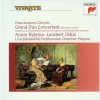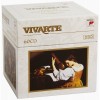传记
Auguste-Joseph Franchomme (10 April 1808 – 21 January 1884) was a French cellist and composer.
Born in Lille, Franchomme studied at the local conservatoire with M. Mas and Pierre Baumann, before continuing his education with Jean-Henri Levasseur and Louis-Pierre Norblin at the Conservatoire de Paris, where he won his first prize only after one year.
He began his career playing with various orchestras and was appointed solo cello at the Sainte-Chapelle in 1828. Along with the violinist Jean-Delphin Alard, teacher of Pablo de Sarasate, and the pianist Charles Hallé, creator of the Hallé Orchestra, he was a founder and member of the Alard Quartet. The Quartet was rare for a chamber ensemble of its time because it consisted of professional musicians. Franchomme also belonged to the founding ranks of the Société des Concerts du Conservatoire.
Franchomme forged close friendships with Felix Mendelssohn, when the latter visited Paris in 1831, and with Frédéric Chopin. In 1833, Chopin and Franchomme collaborated to write a Grand Duo concertant for piano and cello, based on themes from Giacomo Meyerbeer's opera Robert le diable. Franchomme also rewrote the cello parts for Chopin's Polonaise Brillante, Op. 3, and was the dedicatee of Chopin's Cello Sonata, Op. 65. Franchomme was also the dedicatee of the cello sonata of Charles-Valentin Alkan.
With the exception of a trip to England in 1856, Franchomme hardly left Paris, where he became a central figure of the city's musical life. In 1843, he acquired the Duport Stradivarius from the son of Jean-Louis Duport for the then-record sum of 22,000 French francs. He also owned the De Munck Stradivarius of 1730. Franchomme succeeded Norblin as the head professor of cello at the Paris Conservatory in 1846, and his class included Jules Delsart (who succeeded his master), Louis Hegyesi, and Ernest Gillet.
Franchomme was the most celebrated cellist of his time and contributed to the refinement of the bowing technique—elegant, sweet, and light—which distinguished the French school developed by Jean-Pierre, and Jean-Louis Duport. His left hand was renowned for its deft, precise, and expressive powers of execution.
As a composer, Franchomme published some fifty-five works for cello, including the Twelve Caprices, Op. 7, and the Twelve Études, with optional second cello, Op. 35; one cello concerto, Op. 33; as well as numerous other pieces with piano, orchestral, or chamber accompaniment.
For his contributions to music, he was decorated with the Légion d'honneur in 1884








